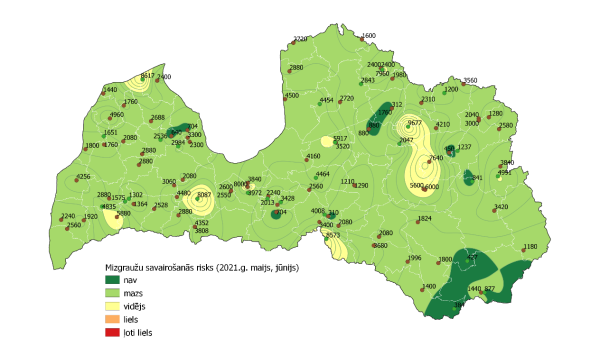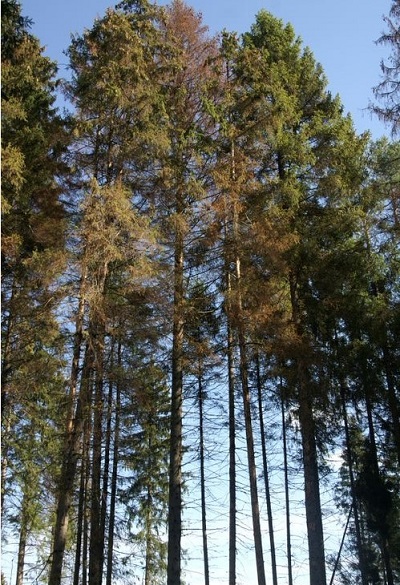Extensive Damage Caused by the Second Generation of the European Spruce Bark Beetle has been Observed in Spruce Stands This Year
Weather conditions this summer, especially in July, have contributed to the damage caused by the dangerous pest, the European spruce bark beetle (Ips typographus), in the spruce stands managed by JSC “Latvia's State Forests” (LVM). Due to the prolonged rainless period and heat in July, spruce stands were subjected to additional stress, which reduced their ability to defend themselves against the bark beetle attack. The greatest damage is currently to be found in the forests of the Lubāna Forest District of LVM North Latgale region – new European spruce bark beetle nests in an area of 147 ha have been identified in spruce stands.
“In order to combat European spruce bark beetles, the most effective method is continuous sanitary felling and pheromone traps set up immediately after felling. It prevents the dangerous pest from spreading even faster, thus damaging also healthy forest stands. Taking into account the currently identified damage, approximately 20 ha of forests will have to be felled in the forests of Lubāna. Selective felling, during which only damaged trees are felled, is not effective in this case, because the bark beetle can remain in the adjacent growing trees and attack again,” tells Jāzeps Zdanovskis, LVM Planning Executive Director.
The first half of this year was cool and thus unfavourable for the development of bark beetles – these pests usually fly in late April, early May, when the air warms to at least +15 degrees. Due to the low air temperatures, the pests did not multiply and the damage caused to the forest stands was small. Evaluating the data on the bark beetles caught in the sample plots established by the Latvian State Forest Research Institute “Silava” and LVM, it can be concluded that the total bark beetle population was low in the first half of the year.
In the photo: The number of bark beetles caught in pheromone traps in May and June
However, in Latvia, this insect develops for two generations and the heat of the second half of the summer promoted the formation of the second generation of pests, the damage caused by which is clearly visible now – spruces begin to turn yellow, the top of the bark is peeling off. Burrowing holes from the ground may also not be identifiable.
In the photo: Severe damage caused by the second generation of bark beetles
The never-ending fight with the bark beetle
The fight against the European spruce bark beetle in the Lubāna area started already back in 2018, when the spruce stands in the territory of the Lubāna wetland were significantly weakened after the prolonged humidity caused by the floods and heavy winds in 2017. The extensive damage caused by bark beetles in this area has also changed the forest management plan, which is also provided for in the action plan for limiting bark beetle damage developed by LVM in 2019.
One adult spruce, about 40 cm in diameter, can house up to 70 000 beetles. A spruce can be destroyed by 3 000 to 5 000 beetles. At low pest intensities, a healthy tree is able to resist bark beetles, but if the number is significant, even entire stands can be destroyed.
“The European spruce bark beetle is the most devastating pest of spruce stands in Latvia – it can cause more damage to spruce stands than all other forest pests taken together; therefore, it is important for foresters to monitor the trees both in spring and now, in autumn, when the second generation of beetles is flying. Tree trunks must be studied: if small run-in holes with the specific brown litter appear there, it is clear that the beetle is already housed in the tree and it is necessary to react as quickly as possible. Currently, the bark beetle is in the larval and young beetle stage, and depending on what the autumn will be like, they will either remain in the trunks of adult spruces or go to the ground for the winter,” tells Jāzeps Zdanovskis, LVM Planning Executive Director.




